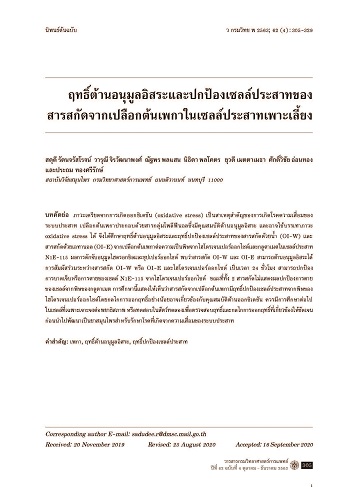ฤทธิ์ต้านอนุมูลอิสระและปกป้องเซลล์ประสาทของสารสกัดจากเปลือกต้นเพกาในเซลล์ประสาทเพาะเลี้ยง
คำสำคัญ:
เพกา, ฤทธิ์ต้านอนุมูลอิสระ, ฤทธิ์ปกป้องเซลล์ประสาทบทคัดย่อ
ภาวะเครียดจากการเกิดออกซิเดชัน (oxidative stress) เป็นสาเหตุสำคัญของการเกิดโรคความเสื่อมของระบบประสาท เปลือกต้นเพกาประกอบด้วยสารกลุ่มโพลีฟีนอลซึ่งมีคุณสมบัติต้านอนุมูลอิสระ และอาจใช้บรรเทาภาวะ oxidative stress ได้ จึงได้ศึกษาฤทธิ์ต้านอนุมูลอิสระและฤทธิ์ปกป้องเซลล์ประสาทของสารสกัดด้วยน้ำ (OI-W) และสารสกัดด้วยเอทานอล (OI-E) จากเปลือกต้นเพกาต่อความเป็นพิษจากไฮโดรเจนเปอร์ออกไซด์และกลูตาเมตในเซลล์ประสาท N1E-115 ผลการดักจับอนุมูลไฮดรอกซิลและซุปเปอร์ออกไซด์ พบว่าสารสกัด OI-W และ OI-E สามารถต้านอนุมูลอิสระได้ การสัมผัสร่วมระหว่างสารสกัด OI-W หรือ OI-E และไฮโดรเจนเปอร์ออกไซด์ เป็นเวลา 24 ชั่วโมง สามารถปกป้องการบาดเจ็บหรือการตายของเซลล์ N1E-115 จากไฮโดรเจนเปอร์ออกไซด์ ขณะที่ทั้ง 2 สารสกัดไม่แสดงผลปกป้องการตายของเซลล์จากพิษของกลูตาเมต การศึกษานี้แสดงให้เห็นว่าสารสกัดจากเปลือกต้นเพกามีฤทธิ์ปกป้องเซลล์ประสาทจากพิษของไฮโดรเจนเปอร์ออกไซด์โดยกลไกการออกฤทธิ์อย่างน้อยอาจเกี่ยวข้องกับคุณสมบัติต้านออกซิเดซัน ควรมีการศึกษาต่อไปในเซลล์ที่เฉพาะเจาะจงต่อพยาธิสภาพ หรือทดสอบในสัตว์ทดลองเพื่อตรวจสอบฤทธิ์และกลไกการออกฤทธิ์ที่เกี่ยวข้องให้ชัดเจนก่อนนำไปพัฒนาเป็นยาสมุนไพรสำหรับรักษาโรคที่เกิดจากความเสื่อมของระบบประสาท
เอกสารอ้างอิง
Mao X, Gu C, Chen D, Yu B, He J. Oxidative stress-induced diseases and tea polyphenols. Oncotarget 2017; 8(46): 81649-61.
Kim GH, Kim JE, Rhie SJ, Yoon S. The role of oxidative stress in neurodegenerative diseases. Exp Neurobiol 2015; 24(4): 325-40.
Niedzielska E, Smaga I, Gawlik M, Moniczewski A, Stankowicz P, Pera J, et al. Oxidative stress in neurodegenerative diseases. Mol Neurobiol 2016; 53(6): 4094-125.
Chang KH, Cheng ML, Chiang MC, Chen CM. Lipophilic antioxidants in neurodegenerative diseases. Clin Chim Acta 2018; 485: 79-87.
Gardner S, Sidisunthorn P, Chayamarit K. Forest trees of Southern Thailand volume 1: acanthaceae to escalloniaceae. Bangkok, Thailand: Kobfai Publishing Project; 2015. p. 242-247.
Santisuk T. Bignoniaceae. In: Smitinand T, Larsen K, editors. Flora of Thailand volume 5, part 1. Bangkok, Thailand: Forest Herbarium, Department of National Parks; 1987. p. 32-37.
ฐานข้อมูลเครื่องยาสมุนไพร คณะเภสัชศาสตร์ มหาวิทยาลัยอุบลราชธานี. เพกา. [ออนไลน์]. [สืบค้น 19 พ.ย. 2562]; [4 หน้า]. เข้าถึงได้จาก URL: http://www.thaicrudedrug.com/main.php?action=viewpage&pid=94.
ประกาศคณะกรรมการพัฒนาระบบยาแห่งชาติ เรื่อง บัญชียาหลักแห่งชาติ พ.ศ. 2562. ราชกิจจานุเบกษา เล่ม 136 ตอนพิเศษ 95 ง (วันที่ 17 เมษายน 2562). หน้า 8.
Sankara S, Nair AGR. Flavonoids of the stem bark of Oroxylum indicum. Curr Sci 1972; 41: 62-3.
Majumdar S, Mohanta BC, Chowdhury DR, Banik R, Dinda B, Basak A. Proprotein convertase inhibitory activities of flavonoids isolated from Oroxylum indicum. Curr Med Chem 2010; 17(19): 2049-58.
Lalrinzuali K, Vabeiryureilai M, Jagetia GC. Investigation of the anti-inflammatory and analgesic activities of ethanol extract of stem bark of Sonapatha Oroxylum indicum in vivo. Int J Inflam 2016; 2016: 8247014. (8 pages).
Siriwatanametanon N, Fiebich BL, Efferth T, Prieto JM, Heinrich M. Traditional used Thai medicinal plants: in vitro anti-inflammatory, anticancer and antioxidant activities. J Ethnopharmacol 2010; 130(2): 196-207.
Ali RM, Houghton PJ, Raman A, Hoult JRS. Antimicrobial and anti-inflammatory activities of extracts and constituents of Oroxylum indicum (L.) Vent. Phytomedicine 1998; 5(5): 375-81.
Laupattarakasem P, Houghton PJ, Hoult JRS, Itharat A. An evaluation of the activity related to inflammation of four plants used in Thailand to treat arthritis. J Ethnopharmacol 2003; 85(2-3): 207-15.
Asaduzzaman M, Nasrin N, Muhit A, Raihan SZ, Apu AS, Akbar A. Antidiarrheal, analgesic and cytotoxic activities of crude extract of Oroxylum indicum (L.) stem bark. J Pharm Res 2011; 4(11): 4296-8.
Tripathy BN, Panda SK, Sahoo S, Mishra SK, Nayak L. Phytochemical analysis and hepatoprotective effect of stem bark of Oroxylum indicum (L) Vent. on carbon tetrachloride induced hepatotoxicity in rat. Int J Pharm Biol Arch 2011; 2(6): 1714-7.
Bharali MK, Konya H, Chetry LB. Protective effect of Oroxylum indicum on acetaminophen induced liver injury in rat. Int Curr Pharm J 2014; 3(2): 223-7.
Radhika LG, Meena CV, Peter S, Rajesh KS, Rosamma MP. Phytochemical and antimicrobial study of Oroxylum indicum. Anc Sci Life 2011; 30(4): 114-20.
Das S, Choudhury MD. Antimicrobial activity of stem bark extracts from the plant Oroxylum indicum Vent. Assam Univ J Sci Technol 2010; 5(1): 95-9.
Chusri S, Sinvaraphan N, Chaipak P, Luxsananuwong A, Voravuthikunchai SP. Evaluation of antibacterial activity, phytochemical constituents and cytotoxicity effects of Thai household ancient remedies. J Altern Complement Med 2014; 20(12): 909-18.
Sireeratawong S, Khonsung P, Nanna U, Vannasiri S, Lertprasertsuke N, Singhalak T, et al. Anti-diarrheal activity and toxicity of Learng Pid Samud recipe. Afr J Tradit Complement Altern Med 2012; 9(4): 519-29.
Chetry LB, Bharali MK. Antiproliferative effect of aqueous bark extract of Oroxylum indicum L. on Vignaradiata L (Green gram) seedlings. J Phytopharmacol 2018; 7(2): 175-9.
Kumar DRN, George VC, Suresh PK, Kumar RA. Cytotoxicity, apoptosis induction and anti-metastatic potential of Oroxylum indicum in human breast cancer cells. Asian Pac J Cancer Prev 2012; 13(6): 2729-34.
Shetgiri PP, Dargi KK, D’Mello PM. Evaluation of antioxidant and antihyperlipidemic activity of extracts rich in polyphenols. Int J Phytomed 2010; 2(3): 267-76.
Mangal P, Khare P, Jagtap S, Bishnoi M, Kondepudi KK, Bhutani KK. Screening of six Ayurvedic medicinal plants for anti-obesity potential: an investigation on bioactive constituents from Oroxylum indicum (L.) Kurz bark. J Ethnopharmacol 2017; 197: 138-46.
Singh J, Kakkar P. Modulation of liver function, antioxidant responses, insulin resistance and glucose transport by Oroxylum indicum stem bark in STZ induced diabetic rats. Food Chem Toxicol 2013; 62: 722-31.
Lalrinzuali K, Vabeiryureilai M, Jagetia GC. Topical application of stem bark ethanol extract of Sonapatha, Oroxylum indicum (L.) Kurz accelerates healing of deep dermal excision wound in Swiss albino mice. J Ethnopharmacol 2018; 227: 290-9.
Saha P, Choudhury PR, Das S, Talukdar AD, Choudhury MD. In vitro antioxidant activity of bark extracts of Oroxylum indicum (L.) vent. Asian J Pharm Clin Res 2017; 10(8): 263-6.
Halliwell B, Gutteridge JMC, Aruoma OI. The deoxyribose method: a simple “test tube” assay for determination of rate constants for reactions of hydroxyl radicals. Anal Biochem 1987; 165(1): 215-9.
Nishikimi M, Rao NA, Yagi K. The occurrence of superoxide anion in the reaction of reduced phenazine methosulfate and molecular oxygen. Biochem Biophys Res Commun 1972; 46(2): 849-54.
Amano T, Richelson E, Nirenberg M. Neurotransmitter synthesis by neuroblastoma clones. Proc Nat Acad Sci USA 1972; 69(1): 258-63.
Kimhi Y, Palfrey C, Spector I, Barak Y, Littauer UZ. Maturation of neuroblastoma cells in the presence of dimethylsulfoxide. Proc Nat Acad Sci USA 1976; 73(2): 462-6.
Mosmann T. Rapid colorimetric assay for cellular growth and survival: application to proliferation and cytotoxicity assays. J Immunol Methods 1983; 65(1-2): 55-63.
Lewerenz J, Maher P. Chronic glutamate toxicity in neurodegenerative diseases--what is the evidence? Front Neurosci 2015; 9: 469. (20 pages).
Prentice H, Modi JP, Wu JY. Mechanisms of neuronal protection against excitotoxicity, endoplasmic reticulum stress, and mitochondrial dysfunction in stroke and neurodegenerative diseases. Oxid Med Cell Longev 2015; 2015: 964518. (7 pages).




